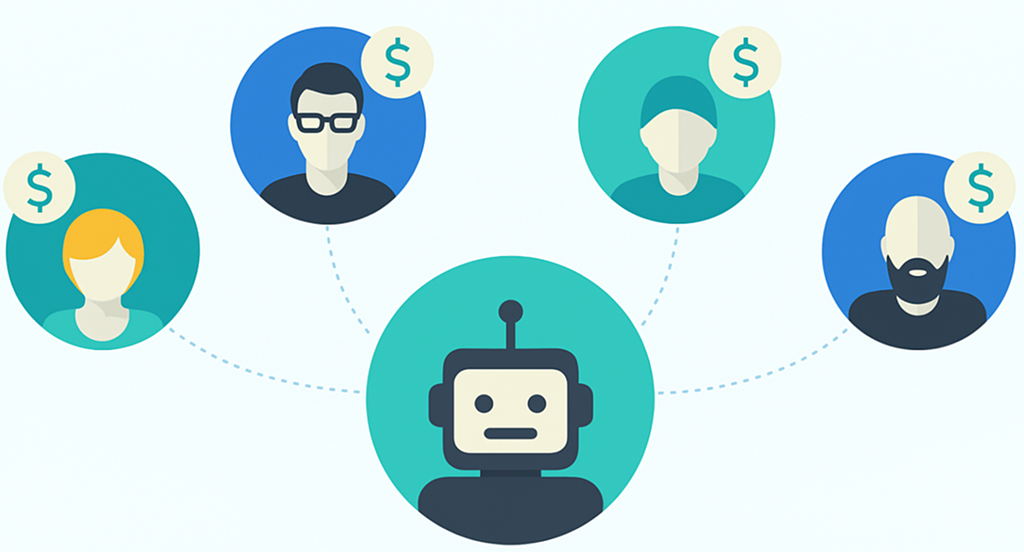Marketing has two jobs: grow revenue and stop waste. AI marketing automation does both.
It turns the repetitive grind (segmentation, scoring, reporting, content ops) into always-on systems that learn, iterate, and compound. If you’ve got leads, channels, and data, AI can make them work harder.
Modern teams run into the same blockers: disconnected tools, shallow reporting, and one-size-fits-all messaging. AI automation breaks those bottlenecks with data unification, modeled audiences, and content that adapts per user then feeds results back into the system to improve the next send.
Key Takeaways
- AI prints ROI when sequenced. Start with per-user send time and one recommendation slot, then layer suppression and bandits to compound lift.
- Decisioning beats rules. Let models pick the next best action; you define guardrails, outcomes, and attribution.
- Organic demand multiplies gains. Feed journeys with authority-driven SEO so your improved targeting meets better traffic.
- Governance is light but real. Holdouts, fallbacks, frequency caps, and monthly model health checks keep you safe while you scale.
- Prove it in 90 days. Ship a timing + recs pilot, track incremental lift, and expand with confidence using the weekly promote/retire loop.
What is AI Marketing Automation
AI marketing automation uses machine learning to decide who, what, when, and where then executes it for you across channels.
Think 1:1 personalization, but without manual labor. The punchline? It compounds and better data makes it smarter.

Traditional automation runs rules you write. AI automation learns the rules you can’t see such as patterns in behavior, timing, and content that drive lift.
At its core, it unifies data (web, app, CRM, ads), builds predictive models (propensity, churn, LTV), selects content and offers dynamically, and triggers actions in your stack (email, push, in-app, ads).
As outcomes flow back, models retrain; journeys refine. The result is a self-improving loop that scales personalization from a few segments to thousands of micro-audiences.
Why now? The stack caught up. GenAI handles language and creative variants; predictive AI handles who/when/what.
Together they cut cycle time from weeks to hours and push relevance beyond human bandwidth. Marketers stop guessing and start orchestrating.
- Core building blocks you’ll actually use:
- Unified customer data: stitched identities, consent, and events (page views, purchases, opens).
- Predictive models: churn risk, next-best product, send-time optimization.
- Decisioning & orchestration: pick message, channel, and timing per user.
- Generative content ops: turn briefs into on-brand copy and creative variants.
- Closed-loop measurement: feed results back to the models to improve the next touch.
- Unified customer data: stitched identities, consent, and events (page views, purchases, opens).
The majority of marketers are already leaning on AI. 63% report active generative AI use; planning intent is even higher, signaling mainstreaming across teams and budgets.
Organizations report gen-AI use roughly doubling within a year, a rare adoption curve in enterprise tech expect capability gaps to widen rapidly.
AI’s upside is not just “time saved.” McKinsey pegs $0.8–$1.2T incremental productivity potential in sales/marketing, combining cost efficiency and revenue lift from better targeting and conversion.
Comparison at a glance:
| Dimension | Manual / Rules-Based | AI-Driven Automation |
| Segmentation | 5–20 static segments | Hundreds–thousands of micro-cohorts updated daily |
| Timing | Batch send windows | Individual send-time optimization per user |
| Offers/Content | Fixed templates | Dynamic creative and offer selection |
| Testing | A/B, slow cycles | Always-on multi-variant with bandit allocation |
| Feedback loop | Monthly reporting | Real-time model retraining and journey tuning |
Where you’ll feel it first (practical wins):
- Time to launch: Go from two-week campaign creation to same-day multi-variant deploy.
- Lift: Predictive audiences + dynamic content typically beat static segments by double-digit CTR/CR improvements.
- Waste reduction: Suppress low-propensity users and shift spend to high-intent cohorts.
- Coverage: Always-on journeys nurture long-tail leads you’d never touch manually.
Field examples and definitions you can trust:
AI + automation together optimize tasks across the marketing spectrum, from segmentation to next-best action orchestration consistent with advanced lifecycle programs.
Practical plays: predictive analytics, hyper-personalization, chatbots, and recommendation engines, now table stakes in modern stacks.
Vendors document AI-enabled orchestration across channels, with learning loops feeding back into decisioning (e.g., Insider and others in cross-channel CX).
Mini-framework: the 4 layers of AI automation
- Data: centralize identifiers, events, and consent.
- Intelligence: model churn, LTV, propensity; classify content.
- Orchestration: decide the next touch per user with guardrails.
- Execution: ship messages/ads across channels; collect results.
How AI Automates Marketing
AI takes the grunt work like segmentation, send timing, content variants, budget shifts, reporting and does it continuously, faster than a human team.
The twist is compounding effects: every cycle gets smarter, so the same campaigns keep pulling more revenue with less effort.
If you’ve ever stalled a launch because lists weren’t clean, variants weren’t ready, or the analytics dashboard lagged, you’ve felt the manual-tax on growth.

AI automation removes that tax. It reads behavior in real time, predicts the next best action per person, generates on-brand copy or product mixes, decides the channel and moment, then feeds the results back into the model.
The outcome isn’t just “hours saved”; it’s a system that hunts incremental conversions you couldn’t see and repeats it every day at scale.
Adoption isn’t theoretical anymore. Marketers increasingly treat AI as the core of orchestration, not a bolt-on.
Platforms that unify customer data, predict behavior, and individualize journeys across channels demonstrate tangible lift: send-time optimization lifts clicks and traffic; dynamic recommendations drive a meaningful share of ecommerce revenue; and predictive audiences often beat static segments on CTR and conversion.
A quick look at “manual vs. AI” workflows and business impact
The following table sketches everyday jobs AI quietly upgrades, and where the ROI shows up first. Each outcome below is drawn from real-world case studies or benchmark research.
| Workflow | Manual Reality | AI-Driven Reality | Typical Impact |
| Send-time & cadence | Batch windows, generic frequency | Per-user send-time & adaptive pacing | Case: OneRoof saw +23% CTOR, +57% unique clicks, +218% total clicks. |
| Product/content recommendations | Static blocks, broad categories | Dynamic, behavior- and affinity-based | Benchmarks show 10–31% of revenue tied to recs; 2.5× conversion vs. generic in a recent large-brand case. |
| Audience building & suppression | Fixed rules, slow refresh | Predictive propensity, churn, LTV | Literature and practitioner guides show gains from better prioritization and shorter cycles; impact varies by funnel stage. |
| Journey orchestration | Linear paths | Contextual next-best-action across channels | Platforms document faster time-to-value and higher engagement from individualized journeys. |
Sources for impacts (in order of appearance): Braze send-time optimization case; Barilliance and Netcore case studies for recommendation revenue share and conversion lift; peer-reviewed lead-scoring review and practitioner guides; cross-channel orchestration vendor documentation. BrazeBarillianceNetcore CloudPMCGrowthJockeyInsider
When you operationalize this, the ROI emerges in three places. First, conversion: better timing plus relevant content wins more clicks and purchases without increasing volume.
Second, efficiency: predictive suppression trims wasted sends and spend, while bandit-style testing automatically routes impressions to winners.
Third, compounding: every send enriches the training data, so next week’s journey is smarter than last week’s.
If you’re rolling this out inside a high-growth or enterprise environment, tie the automation roadmap to the specific revenue levers you own (new logo acquisition, expansion, retention).
If you need a partner fluent in AI-led SEO and content systems to feed those journeys with trustworthy traffic, a specialized AI SEO program can accelerate the compounding effect.
For complex B2B funnels, service lines built for longer cycles and multistakeholder deals help translate predictive insights into pipeline.
One caveat: automation can scale bad content and bad targeting just as fast as the good stuff. If organic growth is in the mix, you still need defensible authority signals and clean link profiles to ensure your AI-generated pages rank and convert over time.
This is where white-hat acquisition and high-authority digital PR converge with AI-assisted content ops; machines help you build, but humans still set quality bars and editorial standards.
5 AI Marketing Automation Tools
Yes, when you pick tools that blend unified data, prediction, and orchestration, you see measurable lift.
The trick is fit: each platform shines in different contexts. Below, five tools worth your budget and what they can do.
HubSpot’s AI Tools
For small and mid-market teams, yes. HubSpot’s AI now touches content, reporting, and journey orchestration so you launch faster and measure cleaner.
The newest assistants sit on your CRM data, which is where the compounding starts. But which plan and which AI should you start with?

HubSpot bundles AI across its customer platform with a growing slate of assistants that generate on-brand content, summarize CRM context, and help automate routine marketing tasks.
The Content Hub includes AI features for blog and page creation with a free tier to get started, while paid Marketing Hub tiers unlock deeper automation and reporting. The point isn’t just faster copy; it’s speed-to-campaign and cleaner measurement inside a single system.
HubSpot has also rolled out Breeze, a free AI companion that works with your CRM context to draft content, prep meetings, and accelerate execution.
Pricing spans from free to starter and professional/enterprise plans, so you can ramp capability without a platform switch as you scale.
In practical terms: if you want AI to sit where your contacts, deals, and journeys already live (and you don’t want to stitch five vendors), HubSpot gives you that “one roof” feel with assistants that increasingly automate the busywork so marketers can focus on offers and strategy.
Quick scoping tip: Start on Free/Starter to validate content workflows, then graduate to Professional once you need predictive scoring, advanced automation, and multi-team reporting.
Optimove
If lifecycle marketing is your growth engine, Optimove’s “self-optimizing journeys” reduce manual decisioning and keep tests always-on.
You trade rigid flows for a decision layer that keeps picking better actions. The question is how fast you can feed it clean data.
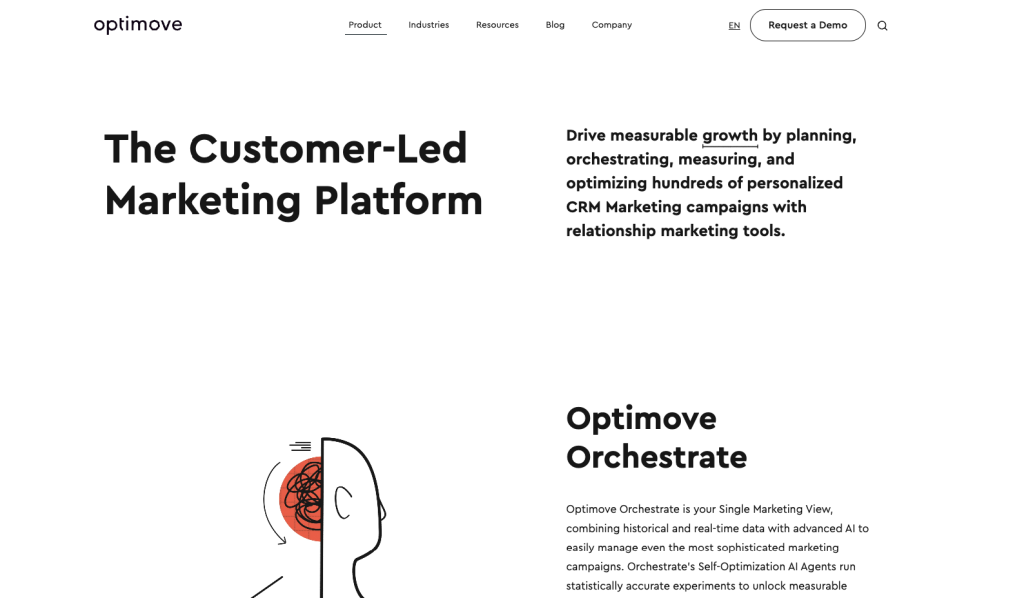
Optimove positions AI at the decisioning layer: given multiple eligible campaigns, the platform chooses the next-best one per customer, learns from the outcome, and improves routing over time.
Their learning center and product blogs outline how self-optimizing campaigns embed testing by default, competing actions per touchpoint, model-driven selection, and continuous uplift measurement so you scale individualized journeys without hand-coding rules for every micro-segment.
This matters when you have dozens of lifecycle messages (onboarding, activation, replenishment, win-back) and can’t afford to A/B them one by one.
Teams report faster iteration cycles and higher campaign uplift once decisioning moves from “marketer picks” to “model picks.” If your CRM lists are healthy and events are trustworthy, you’ll feel gains first in conversion and retention; if your data is messy, the models chase noise.
In short: Optimove is strongest where there’s rich behavioral data and a need to orchestrate many campaigns per customer across weeks or months.
Insider AI
For brands running cross-channel CX at scale, Insider’s AI helps centralize data, predict behavior, and individualize messaging across web, app, email, push, and ads.
It’s built for speed from a single platform. The catch: it shines when you commit to orchestration not just single campaigns.
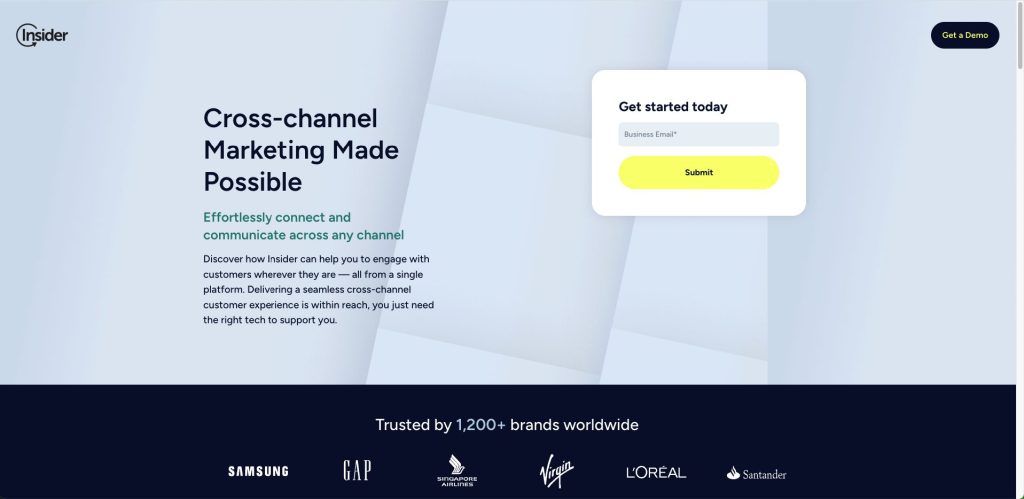
Insider leads with an AI-native, cross-channel approach: unify data via its CDP, build predictive audiences, and orchestrate one-to-one journeys with Architect.
That means less tool-hopping and fewer brittle integrations when you want email, on-site, in-app, and ad audiences to agree. Vendor materials emphasize time-to-value and individualized experiences, while third-party review sites position Insider among leaders in personalization engines for enterprise teams.
Practically, you’ll lean on Insider when you need dynamic segments that update in real time, predictive targeting for ad spend efficiency, and creative that adapts per user as they move between channels.
The platform also markets measurable productivity gains from combining generative, predictive, and conversational AI, useful when you’re scaling variants without adding headcount.
If your immediate need is a single-channel email fix, this may be overkill; if your mandate is to harmonize the entire lifecycle across channels, it’s a compelling fit.
Klaviyo AI
Yes, especially for ecommerce and product-led brands. Klaviyo’s Smart Send Time and predictive analytics help you reach the right person at the right moment with the right SKU.
The nuance is training: models improve as your event and order data deepen. Klaviyo builds AI into core messaging decisions.
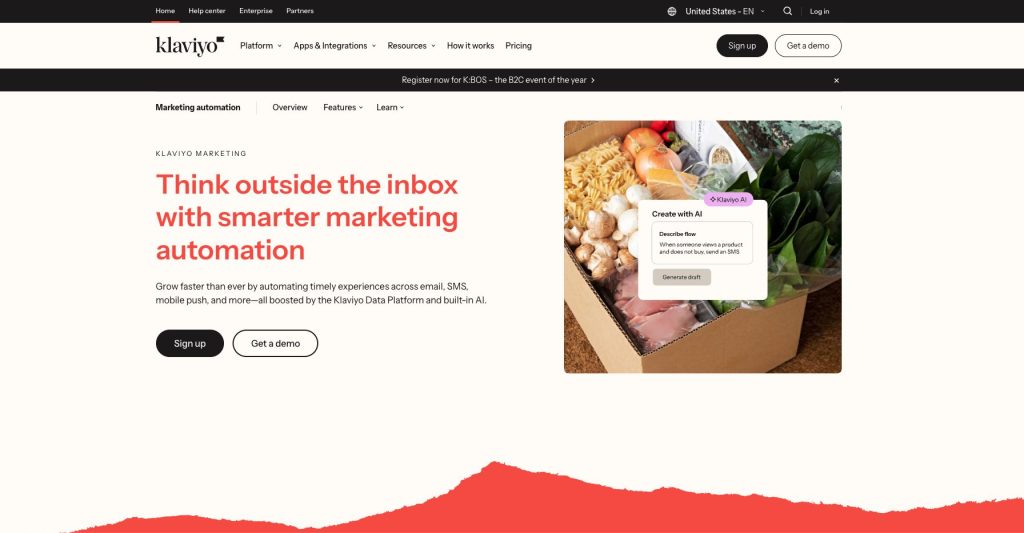
Smart Send Time analyzes your own engagement data to identify the optimal send window per audience, improving open and click rates without adding volume.
On top of timing, Klaviyo’s predictive analytics estimate metrics like expected date of next order or predicted CLV, helping you prioritize segments and suppress low-propensity users.
The platform also layers generative features (e.g., AI-assisted copy) so you can scale variants once the audience math is working.
For teams with sparse order histories or inconsistent tracking, start with Smart Send Time and a single recommendation slot to collect the data you’ll need for the more advanced predictions.
Operator note: Always keep a holdout on timing and recommendations. Klaviyo’s dashboards show why a send time was chosen, which helps you build internal trust in the model.
Braze Intelligence Suite
Yes, Braze publishes case studies with hard numbers. Send-Time Optimization alone has delivered triple-digit click gains for some brands.
The bigger story is orchestration: once timing works, its bandits and targeting features compound results. Can your content keep up?
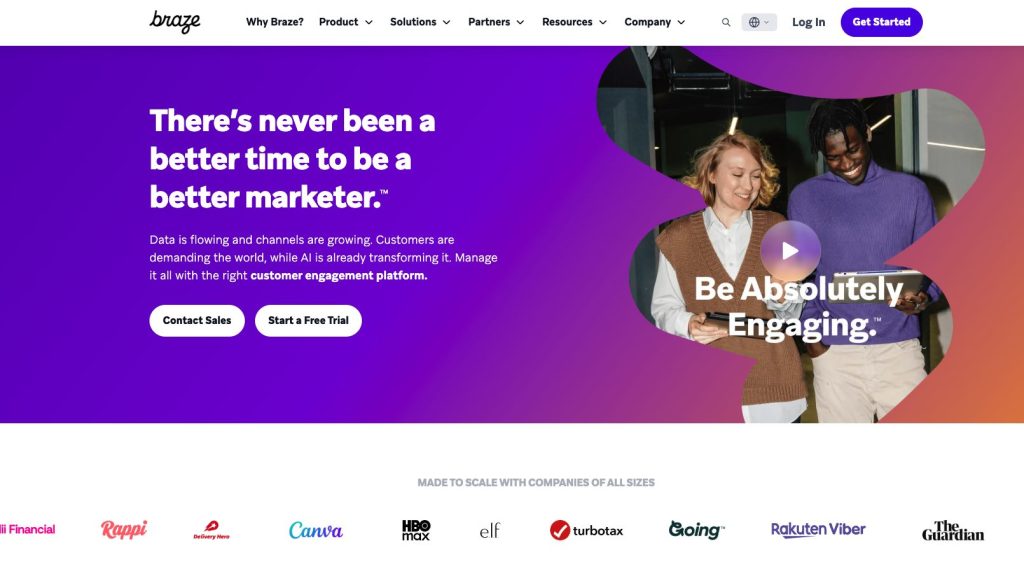
Braze focuses AI on the when and what of messaging at scale. The Intelligence Suite includes Intelligent Timing (send-time optimization), Intelligent Selection (multi-armed bandits for message variants), and predictive segmentation to route users into higher-yield journeys.
Public case studies show outsized gains when brands move from batch scheduling to individualized timing and targeted content.
OneRoof, a property platform, reported a 23% lift in click-to-open rate and a 218% increase in total clicks after turning on Intelligent Timing and related features.
Those are the kinds of deltas you feel in weekly KPIs, not just slideware. Execution-wise, Braze pairs well with product analytics stacks and mobile-heavy businesses that need speed and real-time context.
If your team has limited creative bandwidth, start with timing and one high-impact message slot; let bandits auto-allocate traffic to winners before you scale to more variants.
Snapshot: Which tool fits where?
The table below is where these platforms typically excel and what to watch for during evaluation.
| Tool | Best For | Signature AI Capability | Proof Point |
| HubSpot | SMB–mid-market teams wanting CRM + marketing under one roof | AI content + assistants on top of Smart CRM | Free → Pro tiers, AI content + Breeze assistant accelerate launch cycles |
| Optimove | Lifecycle-heavy CRM programs | Self-optimizing journeys (model-driven next-best-campaign) | Continuous uplift via embedded testing/decisioning |
| Insider | Enterprise-grade cross-channel personalization | AI-native orchestration across web, app, email, push, ads | Recognized in personalization; vendor claims rapid time-to-value |
| Klaviyo | Ecommerce & product-led messaging | Smart Send Time + predictive CLV/next order | Data-driven timing and predictions baked into flows |
| Braze | Real-time, mobile-heavy brands | Intelligence Suite: send-time, bandits, predictive segments | OneRoof: +23% CTOR, +218% total clicks |
Why You Should Use AI Marketing
Because AI doesn’t just “save time”. It also compounds revenue. It personalizes at scale, times messages perfectly, and reallocates budget to what’s working.
The kicker: every campaign trains the next one, so your lift doesn’t fade.
If your team is still arguing about send windows, segment rules, or which creative to ship, you’re paying an invisible tax. AI removes that tax by automating the three levers that actually move P&L: who to target, when to engage, and what to show.
Independent research backs the upside. McKinsey estimates generative AI can raise marketing productivity by 5–15% of total marketing spend, translating into hundreds of billions in value globally and that’s incremental to earlier analytics gains.
Adoption isn’t a niche trend either; survey data shows global AI adoption jumped to 72% by early 2024, meaning the comp set is already compounding.
On performance, AI-timed sends and personalized recommendations repeatedly deliver outsized engagement and revenue shares in the real world. The point isn’t novelty; it’s a durable advantage that gets harder to catch the longer you wait.
| Reason | Mechanism | Representative Evidence |
| More revenue per message | Individual send-time and cadence lift engagement without increasing volume | OneRoof recorded +23% CTOR, +57% unique clicks, +218% total clicks with AI timing and dynamic content (Braze cases & docs). |
| Higher average order value | Personalized product/content recommendations increase relevance and basket size | Peer-reviewed 2024 study: recommendations account for up to 31% of e-commerce revenue (12% average). |
| Budget efficiency | Predictive suppression shifts spend away from low-propensity users | Vendor and practitioner literature show fewer wasted sends and better CPA/ROAS when low-likelihood cohorts are throttled. |
| Compounding productivity | Faster cycles, more tests, same headcount | McKinsey: gen-AI raises marketing productivity 5–15%; adoption surging to 72% in 2024 means the gap widens over time. |
If you can’t point to one live automation that 1) times messages per user, 2) rotates message variants with a bandit, and 3) suppresses low-propensity audiences – then your program is still manual where it matters most.
Fix those three, and the comps will notice. If you feed the system with net-new, qualified demand from organic search, the flywheel turns even faster because you’re sending smarter messages to better traffic.
How To Get Started With Marketing Automation
Stand up one channel, one prediction, one creative decision and prove lift in 90 days. Start with timing and recommendations, add predictive suppression, then scale journeys.
The trick isn’t tools; it’s sequencing. Ready to turn “pilot” into pipeline?
If you operate in ecommerce or product-led growth, platforms like Klaviyo and Braze make that exact crawl-walk-run pragmatic: switch on Smart Send Time/Intelligent Timing, drop in a rec slot, and let predictive analytics score who’s likely to buy next.
If you’re orchestrating complex lifecycle programs, decisioning layers such as Optimove’s Self-Optimizing Journeys and enterprise orchestration like Insider’s Architect handle “which message next” across channels with less manual routing.
90-Day AI Rollout You Can Actually Ship
Below is a no-drama plan. Each phase has one owner, one model, and one test. Keep a control group in every phase to track incremental lift.
| Phase & Timing | Objective | What You Ship | Primary KPI | Notes |
| Weeks 1–2 | Data readiness | Verify identity stitching (email/phone), map purchase & engagement events, define consent states | Data coverage (% users with last 90-day events) | Create a single spec for events used by timing/recs; missing data is the #1 slowdown. |
| Weeks 3–4 | Quick win #1: Timing | Turn on per-user send-time optimization for 1 recurring campaign | CTOR, unique clicks | Case evidence: +23% CTOR, +218% total clicks when moving to individualized timing. |
| Weeks 5–6 | Quick win #2: Recs | Add one product/content recommendation slot to lifecycle email or homepage | Revenue share from rec slot | Benchmarks: recs can contribute up to 31% of revenue (avg ~12%). |
| Weeks 7–8 | Waste reduction | Enable predictive suppression for low-propensity users (or fatigue scoring) | Send reduction (%), CPA/ROAS | Shift budget/sends from low- to high-propensity cohorts; watch unsub/fatigue. |
| Weeks 9–10 | Always-on testing | Turn on bandit allocation for subject lines/hero | Winner adoption time, incremental CTR | Bandits auto-route to winners and speed learning cycles. |
| Weeks 11–12 | Close the loop | Weekly model refresh, holdout readout, executive dashboard | Incremental revenue, time-to-launch | Lock in an attribution view and standardize the weekly update so gains persist. |
A few practical caveats keep this smooth. Timing models need a baseline of engagement data, if a cohort is new or sparse, platforms fall back to your workspace’s popular hour or a sensible default.
Recs work best when your catalog and event stream are tidy. And predictive audiences improve as you feed more outcomes, so don’t expect perfect accuracy on day one; expect directional wins that compound.
KPI Targets
Set ranges informed by public studies and vendor docs. Then ask finance to bless the math before you scale.
| KPI | Baseline Example | 30–60 Day Range | 90-Day Ambition | Evidence Anchor |
| Click-to-Open Rate (CTOR) | 12% | +5–15% | +15–25% | Send-time optimization case: +23% CTOR. |
| Total Clicks (per send) | 10,000 | +10–40% | +40–100% | OneRoof reported +218% clicks after AI timing + dynamic content. |
| Revenue from Recs | 8% | 10–18% | 15–25% | Studies show avg ~12%, up to 31% of revenue via recs. |
| Wasted Sends (suppressed) | 0% | 5–15% reduced | 15–25% reduced | Predictive suppression improves efficiency; watch CPA/ROAS. |
| Time to Launch (days) | 10 | 5–7 | 3–5 | Gen-AI + orchestration raise productivity 5–15% of spend; speed is the visible win. |
These ranges are conservative compared to some case studies. They keep stakeholders honest while giving you air cover to iterate.
The bigger picture: reputable research pegs marketing productivity gains from generative AI at 5–15% of total spend, with top-down estimates of $0.8–$1.2T incremental value across sales and marketing.
Conclusion
If you’ve followed the plan so far, you’ve seen how timing, recommendations, and predictive suppression create a compounding loop: better engagement → cleaner data → smarter decisioning → even better engagement.
The best part? You don’t need a massive rebuild to feel the gains—just disciplined sequencing and weekly readouts.
Here’s the high-level play that separates operators from dabblers. Start with one recurring message and one dynamic slot so you can attribute lift cleanly.
Pair it with per-user send time to raise clicks without sending more. Turn on predictive suppression so you stop wasting impressions on low-propensity users.
As those models stabilize, introduce bandit allocation for creative and scale into cross-channel journeys where a decisioning layer can arbitrate “what’s next” for each user.
This is how you compound outcomes instead of starting over every quarter.
FAQ – AI Marketing Automation
What’s the fastest ROI lever to switch on?
Per-user send-time optimization on a recurring lifecycle message. It lifts clicks without more volume, so finance can’t argue with the math.
How many audience segments do I actually need?
Fewer than you think. Let predictive audiences create micro-cohorts automatically; you curate the guardrails and exclusions.
Do I need a CDP to start?
Not always. If your messaging platform unifies events and identities well enough, start there. Add a CDP when cross-channel data gets messy.
How do I prove incrementality fast?
Keep a persistent holdout per audience. Report deltas weekly on click-to-open, total clicks, conversions, and revenue from recommendations.
Which comes first, creative or models?
Models. Fix timing and targeting first so creative gets a fair trial. Then feed a few strong variants and let bandits allocate.
What if my product catalog is small?
Use content recommendations or “next best action” logic (e.g., education, demos, offers) instead of only SKU-based picks.
How do I keep the team from getting overwhelmed?
Sequence work: timing → single rec slot → suppression → bandits → cross-channel journeys. One owner per step, one KPI each.
Where do links and authority fit in?
They’re the fuel for sustainable demand. Pair AI-led orchestration with defensible authority building to compound organic results.


